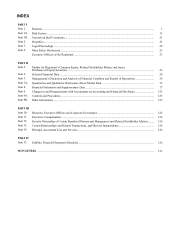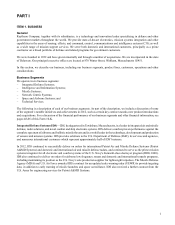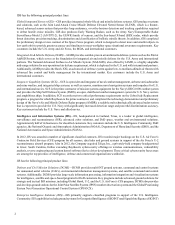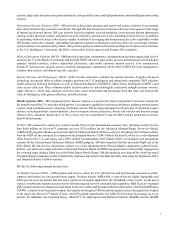Raytheon 2012 Annual Report Download - page 18
Download and view the complete annual report
Please find page 18 of the 2012 Raytheon annual report below. You can navigate through the pages in the report by either clicking on the pages listed below, or by using the keyword search tool below to find specific information within the annual report.10
In connection with certain foreign sales, we utilize the services of sales representatives who are paid commissions in return
for services rendered.
The export from the U.S. of many of our products may require the issuance of a license by either the U.S. Department of State
under the Arms Export Control Act of 1976 (formerly the Foreign Military Sales Act) and its implementing regulations under
the ITAR, the U.S. Department of Commerce under the Export Administration Act and its implementing regulations as kept
in force by the International Emergency Economic Powers Act of 1977 (IEEPA), and/or the U.S. Department of the Treasury
under IEEPA or the Trading with the Enemy Act of 1917. Such licenses may be denied for reasons of U.S. national security
or foreign policy. In the case of certain exports of defense equipment and services, the Department of State must notify Congress
at least 15-30 days (depending on the identity of the importing country that will utilize the equipment and services) prior to
authorizing such exports. During that time, Congress may take action to block or delay a proposed export by joint resolution
which is subject to Presidential veto. Additional information regarding the risks associated with our international business is
contained in Item 1A “Risk Factors” of this Form 10-K.
Backlog
Our total backlog of orders was $36.2 billion at December 31, 2012 and $35.3 billion at December 31, 2011. Included in total
backlog was $28.5 billion and $28.4 billion from the U.S. Government at December 31, 2012 and 2011, respectively. Included
in U.S. Government backlog was foreign military sales backlog of $5.4 billion and $6.3 billion at December 31, 2012 and
2011, respectively. Also included in total backlog was direct foreign government backlog and non-government foreign backlog
of $6.8 billion and $0.4 billion at December 31, 2012 and $6.1 billion and $0.5 billion at December 31, 2011, respectively.
Also included in total backlog was $0.4 billion and $0.3 billion of non-U.S. government domestic backlog at December 31,
2012 and 2011, respectively. Total international backlog including foreign military sales backlog was $12.7 billion or 35% of
total backlog at the end of 2012 compared with $13.0 billion or 37% of total backlog at the end of 2011. Approximately $18.1-
$18.6 billion of the 2012 year-end backlog is not expected to be filled during the following twelve months. These amounts
include both funded backlog (unfilled orders for which funding is authorized, appropriated and contractually obligated by the
customer) and unfunded backlog (firm orders for which funding has not been appropriated or obligated to us). For additional
information related to backlog figures, see “Segment Results” within Item 7 of this Form 10-K.
Research and Development
We conduct extensive research and development activities to continually enhance our existing products and services, and
develop new products and services to meet our customers’ changing needs and requirements, and address new market
opportunities. During 2012 we expended $704 million on research and development efforts and $625 million in both 2011
and 2010. These expenditures principally have been for product development for the U.S. Government, including bid and
proposal efforts related to U.S. Government programs. We also conduct funded research and development activities under
U.S. Government contracts which are included in total net sales. For additional information related to our research and
development activities, see “Note 1: Summary of Significant Accounting Policies” within Item 8 of this Form 10-K.
Raw Materials, Suppliers and Seasonality
We are dependent upon the delivery of materials by suppliers, and the assembly of major components and subsystems by
subcontractors used in our products. Some products require relatively scarce raw materials. In addition, we must comply with
specific procurement requirements which may, in effect, limit the suppliers and subcontractors we may utilize. In some
instances, for a variety of reasons, we are dependent on sole-source suppliers. We enter into long-term or volume purchase
agreements with certain suppliers and take other actions to ensure the availability of needed materials, components and
subsystems. We are also dependent on suppliers to provide genuine original equipment manufacturer parts and have a robust
set of standardized policies to detect counterfeit material, especially electronic components, throughout our supply chain. We
generally have not experienced material difficulties in procuring the necessary raw materials, components and other supplies
for our products. We also are subject to rules promulgated by the Securities Exchange Commission (SEC) in 2012 pursuant
to the Dodd-Frank Wall Street Reform and Consumer Protection Act that require public companies to conduct due diligence
on and disclose whether certain materials (including tantalum, tin, gold and tungsten), known as conflict minerals, that originate
from mines in the Democratic Republic of the Congo or certain adjoining countries, are used in products that we manufacture.
The first report is due by May 31, 2014 for the 2013 calendar year and we are implementing appropriate measures to comply
with such requirements.
In recent years, our revenues in the second half of the year have generally exceeded revenues in the first half. The timing of
new program awards, the availability of U.S. Government funding and product delivery schedules are among the factors
























